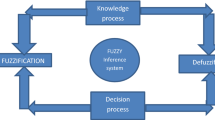Abstract
This paper presents a Takagi Sugeno (TS) fuzzy method for predicting future monthly water consumption values from three antecedent water consumption amounts, which are considered as independent variables. Mean square error (MSE) values for different model configurations are obtained, and the most effective model is selected. It is expected that this model will be more extensively used than Markov or ARIMA (AutoRegressive Integrated Moving Average) models commonly available for stochastic modeling and predictions. The TS fuzzy model does not have restrictive assumptions such as the stationarity and ergodicity which are primary requirements for the stochastic modeling. The TS fuzzy model is applied to monthly water consumption fluctuations of Istanbul city in Turkey. In the prediction procedure only lag one is considered. It is observed that the TS fuzzy model preserves the statistical properties. This model also helps to make predictions with less than 10% relative error.
Similar content being viewed by others
References
Bardossy, A. and Disse, M., 1993, ‘Fuzzy rule based models for infiltration’, Water Resour. Res. 29(2), 373–382.
Davis, W. U., Rodrigo, D., Opitz, B., Dziegielewski, B., Baumann, D. D. and Boland, J., 1988, IWR-Main Water Use Forecasting System, Version 5.1: User's Manual and System Description, IWR-Report 88-R-6, U.S. Army Corps of Engineers Institute for water resources, Fort Belvoir, VA.
Eroğlu, V. and Sarıkaya, H. Z., 1998, ‘Achievements Towards Better Water Supply and Wastewater Disposal in Istanbul’, Proceedings of the International Symposium on Water Supply and Treatment, 22–27 May, Istanbul, Turkey.
Faye, R. M., Sawadogo, S., Mora-Camino, F. and Achaibou, A. K., 2000, ‘Fuzzy modeling approach for the long term management of water resource systems’, IEEE International Conference on Fuzzy Systems 1, 499–504.
Froukh, M. L., 2001, ‘Decision-support system for domestic water demand forecasting and management’, Water Resour. Manag. 15, 363–382.
ISKI., 2003, Briefing Notes of the Office of Head of the Water Supply and Distribution Department for The Year of 2003, ISKI, Aksaray, Istanbul. (In Turkish.)
Jain, A., Varshney, A. K. and Joshi, U. C., 2001, ‘Short-term water demand forecast modelling at IIT Kanpur using artificial neural networks’, Water Resour. Manag. 15(5), 299–321.
Jairaj, P. G. and Vedula, S., 2000, ‘Multireservoir system optimization using fuzzy mathematical programming’, Water Resour. Manag. 14(6), 457–472.
Johnson, P. A. and Ayyub, B. M., 1996, ‘Modeling uncertainty in prediction of pier scour’, J. Hydraul. Eng. 122(2), 66–72.
Kindler, J., 1992, ‘Rationalizing water requirements with aid of fuzzy allocation model’, J. Water Resour. Plan. Manag. 118(3), 308–323.
Lee, H. K., Oh, K. D., Park, D. H., Jung, J. H. and Yoon, S. J., 1997, ‘Fuzzy expert system to determine stream water quality classification from ecological information’, Water Sci. Technol. 36(12), 199–206. Water Quality Conservation in Asia.
Lertpalangsunti, N., Chana, C. W., Mason, P. and Tontiwachwuthikul, P., 1999, ‘A toolset for construction of hybrid intelligent forecasting systems: Application for water demand prediction’, Artif. Intell. Eng. 13, 21–42.
Maidment, D. R. and Parzen, E., 1984a, ‘Time patterns of water use in six Texas cities’, J. Water Resour. Plan. Manag. 110(1), 90–106.
Maidment, D. R. and Parzen, E., 1984b, ‘Cascade model of monthly municipal water use’, Water Resour. Res. 20(1), 15–23.
Mamdani, E. H., 1974, ‘Application of fuzzy algorithms for simple dynamic plant’, Proc. IEE 121, 1585–1588.
Mays, L. W. and Tung, Y.-K., 1992, Hydrosystems Engineering and Management, McGraw-Hill, New York, 515 pp.
Pappis, C. P. and Mamdani, E. H., 1977, ‘A fuzzy controller for a traffic junction’, IEEE Trans. Syst. Man Cybern. 7(10), 707–717.
Pongracz, R., Bogardi, I. and Duckstein, L., 1999, ‘Application of fuzzy rule-based modeling technique to regional drought’, J. Hydrol. 224(3–4), 100–114.
Ross, J. T., 1995, Fuzzy Logic With Engineering Applications, McGraw Hill, New York, 593 pp.
Sastri, T. and Valdes, J. B., 1989, ‘Rainfall intervention analysis for on-line applications’, J. Water Resour. Plan. Manag. 115(4), 397–415.
Shimakawa, M. and Murakami, S., 2003, ‘Fuzzy prediction model for water demand prediction using an interpolative fuzzy reasoning’, Int. J. Syst. Sci. 34(14–15), 775–785.
Shrestha, B. P., Duckstein, L. and Stakhiv, E. Z., 1996, ‘Fuzzy rule-based modeling of reservoir operation’, J. Water Resour. Plan. Manag. 122(4), 262–269.
Şen, Z., 1998, ‘Fuzzy algorithm for estimation of solar irradiation from sunshine duration’, Solar Energy 63(1), 39–49.
Şen, Z. and Kadıoğlu, M., 1998, ‘Simple daily dynamic adaptive operation rule for water supply reservoirs in Istanbul metropolitan area’, International Symposium on Water Supply and Treatment, 22–27 May, Istanbul, Turkey.
Şen, Z., Altunkaynak, A. and Özger, M., 2003, ‘Autorun persistence of hydrologic design’, J. Hydrol. Eng. 8(6), 329–338.
Şen, Z. and Altunkaynak, A., 2004, ‘Fuzzy awakening in rainfall-runoff modeling’, Nord. Hydrol. 35(1), 31–43.
Şen, Z., 2004, Fuzzy Logic and System Models in Water Sciences, Turkish Water Foundation, Istanbul, 314 pp.
Takagi, T. and Sugeno, M., 1985, ‘Fuzzy identification of systems and its application to modeling and control’, IEEE Trans. Syst. Man. Cybern. 15, 116–132.
Xiong, L., Shamseldin, A. Y. and O'Connor, M. K., 2001, ‘A non-linear combination of the forecasts of rainfall-runoff models by the first order Takagi-Sugeno fuzzy system’, J. Hydrol. 245, 196–217.
Zadeh, L. A., 1965, ‘Fuzzy sets’, Inform. Control 12(2), 94–102.
Zhou, S. L., McMahon, T. A., Walton, A. and Lewis, J., 2002, ‘Forecasting operational demand for an urban water supply zone’, J. Hydrol. 259, 189–202.
Author information
Authors and Affiliations
Corresponding author
Rights and permissions
About this article
Cite this article
Altunkaynak, A., Özger, M. & Çakmakci, M. Water Consumption Prediction of Istanbul City by Using Fuzzy Logic Approach. Water Resour Manage 19, 641–654 (2005). https://doi.org/10.1007/s11269-005-7371-1
Received:
Accepted:
Issue Date:
DOI: https://doi.org/10.1007/s11269-005-7371-1




